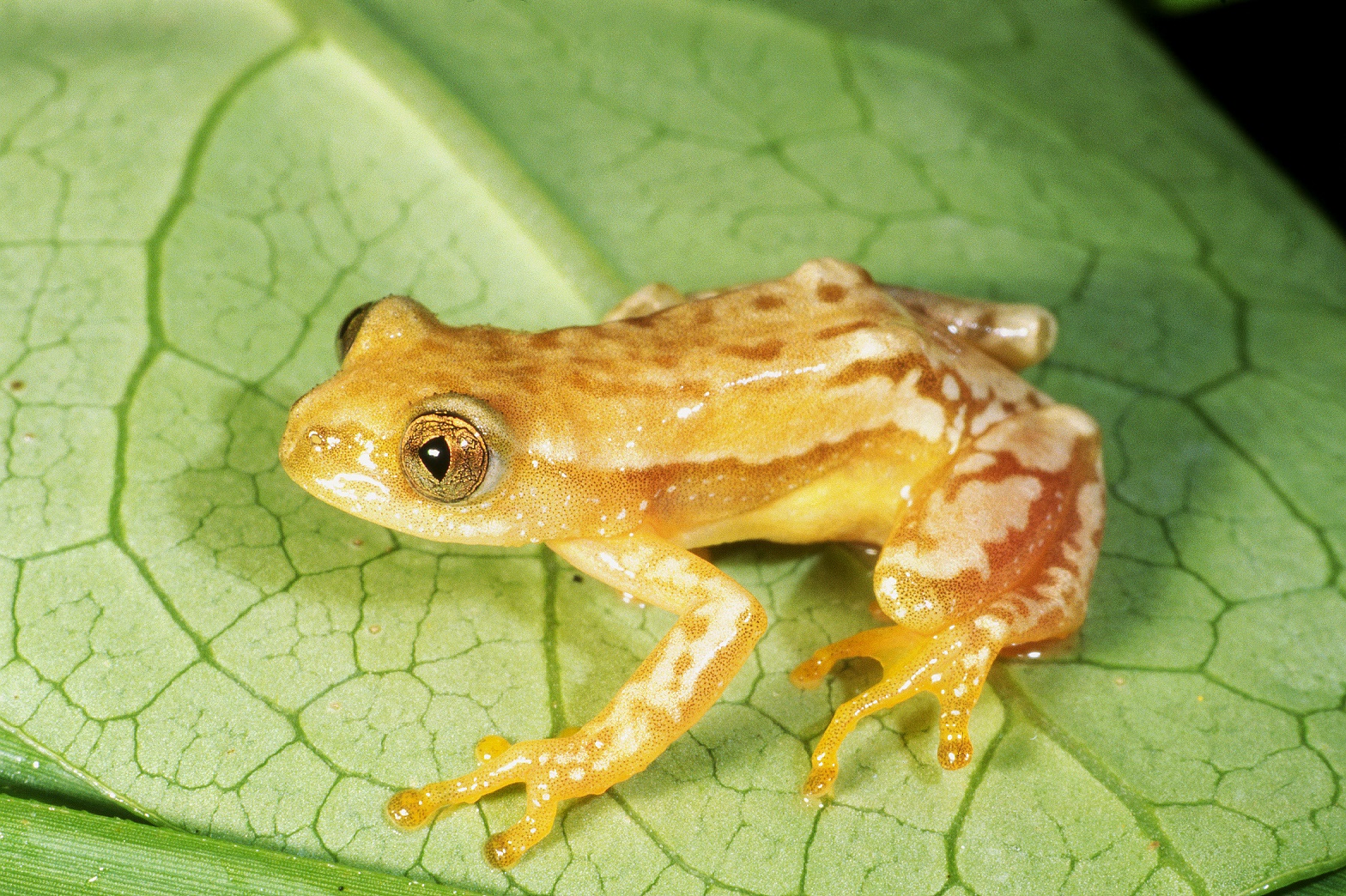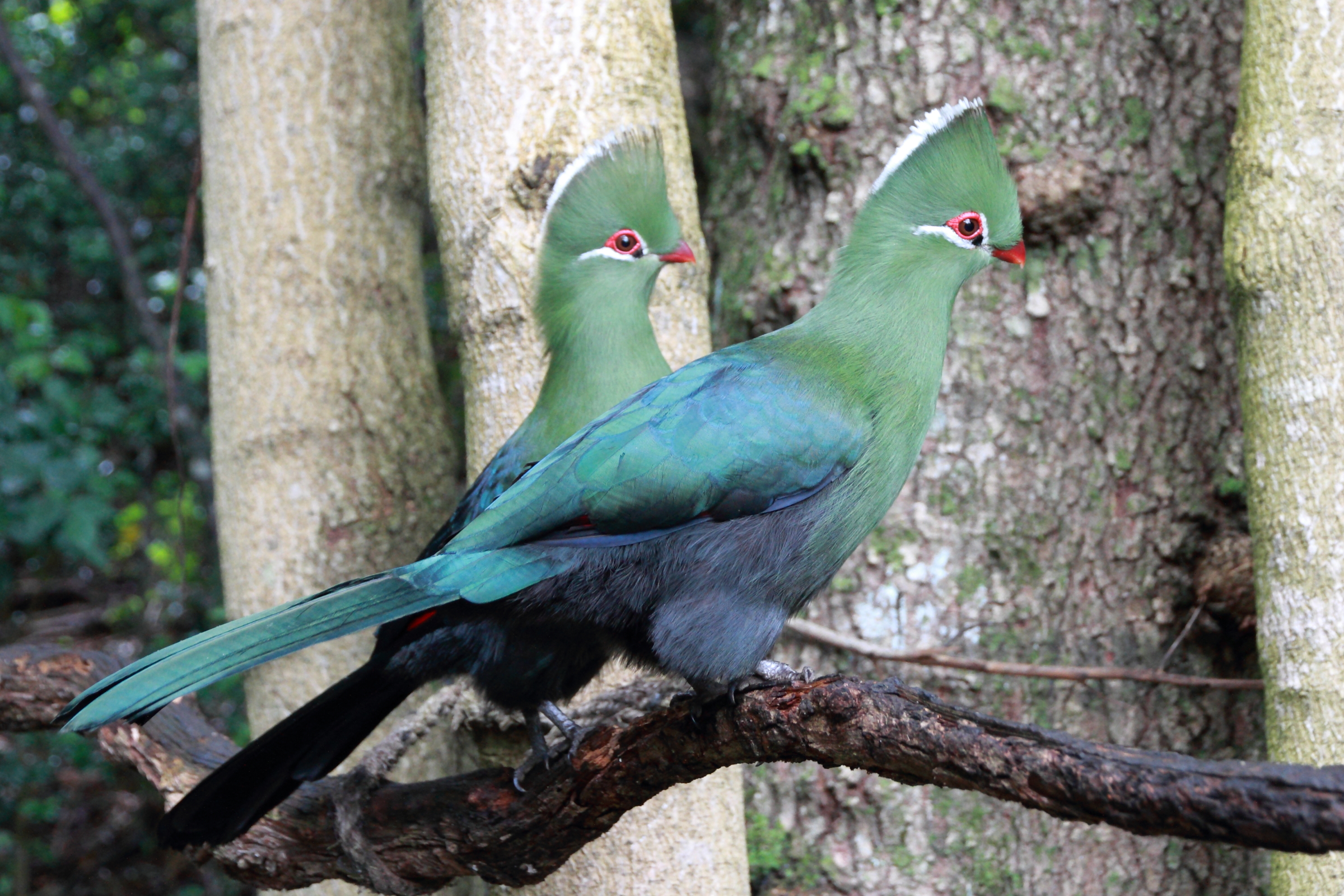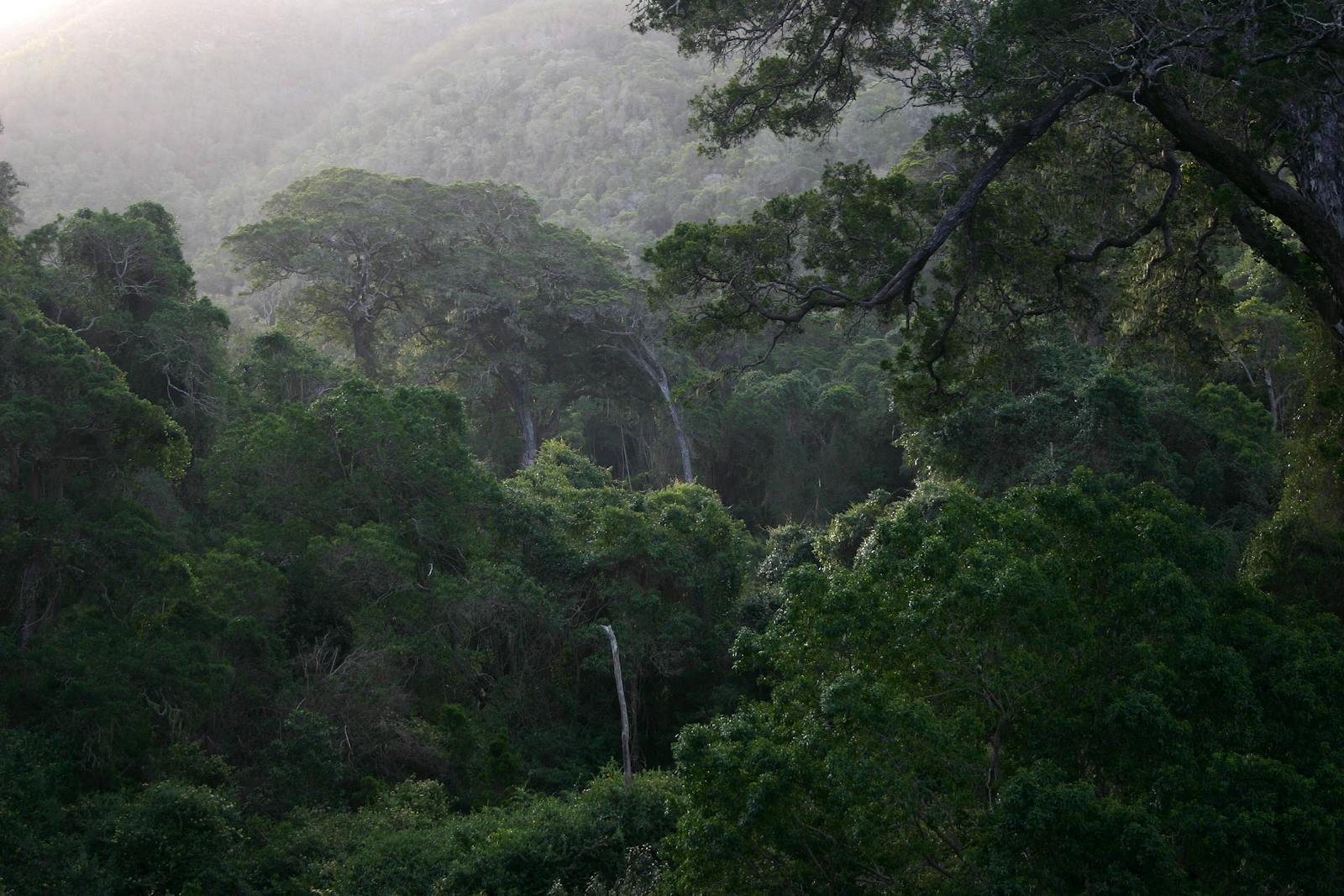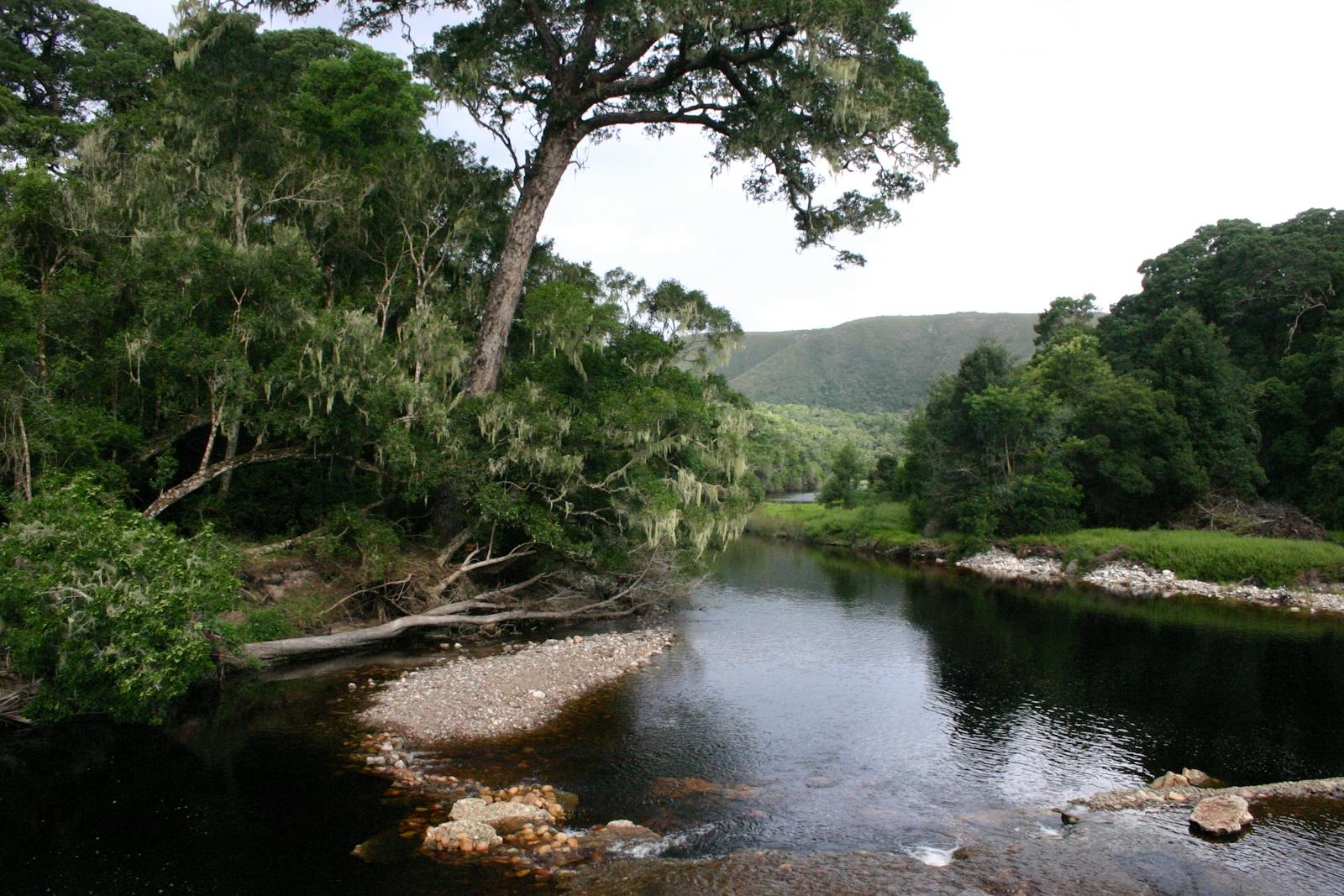Knysna-Amatole Montane Forests
The ecoregion’s land area is provided in units of 1,000 hectares. The protection goal is the Global Safety Net (GSN1) area for the given ecoregion. The protection level indicates the percentage of the GSN goal that is currently protected on a scale of 0-10.
Bioregion: South African Cape Shrublands & Mountain Forests (AT2)
Realm: Afrotropics
Ecoregion Size (1000 ha):
207
Ecoregion ID:
15
Conservation Target:
50%
Protection Level:
7
States: South Africa
The Knysna-Amatole Montane Forests are home to the remnants of the southernmost population of African bush elephant. Itself containing some of the southernmost Afromontane forests in Africa, the ecoregion is part of the archipelago-like Afromontane regional center of plant endemism. Other than the charismatic megaherbivore, The leopard is the largest predator of the Knysna forests, however, they are thought to be nearly extinct locally.

The flagship species of the Knysna-Amatole Montane Forests ecoregion is the Knysna banana frog. Image credit: Wildscreen Exchange
The ecoregion is divided into two distinct portions, the Knysna forest along the coast (568 km2) and the Amatole forests further inland (405 km2). Much of the Knysna forest occurs on gentle to moderate slopes, ranging from 5 m to 1,220 m above sea level, with a mean of 240 m. The forests of the Amatole Mountains are situated at higher altitudes, between 700 m and 1,250 m.
Rain falls throughout the year, with maxima in early and late summer. Mean daily maximum and minimum temperatures in the Knysna forest are 23.8°C in February (summer) and 18.2°C in August (winter), and in the Amatole forests the maxima and minima are 19.7°C and 8.9°C. Annual rainfall varies between the sites as well, ranging from 525 mm to 1,220 mm in the Knysna forest, and from 750 mm to 1,500 mm in the Amatole forest.
Rainfall appears to be the primary environmentally limiting factor to forest extent, as forest is unable to persist in areas with rainfall of less than 500 mm per year. Although climatic factors appear to be responsible for large-scale forest distribution, small-scale patterns are determined primarily by fire. Common trees in these forests include ironwood, stinkwood, Outeniqua yellowwood, real yellowwood, Cape holly, white pear, Cape beech, bastard saffron, and Cape plane.

Knysna Turacos. Image credit: Anton Frolich, Creative Commons
The Knysna-Amatole Montane Forests are part of the archipelago-like Afromontane regional centre of plant endemism. However, within this ecoregion tree endemism is low, and few of the plant species are rare. The ecoregion contains one strict endemic mammal species, the long-tailed forest shrew and one near endemic mammal species, Duthie’s golden mole. Near-endemic birds include the Knysna turaco, Knysna scrub-warbler, Knysna woodpecker, chorister robin-chat, and forest canary. These forests are also home to the strictly endemic Knysna dwarf chameleon. Amphibian species restricted mainly to the Knysna forests include the treefrog, Knysna banana frog, the southern (Koyal) ghost frog, and plain rain frog. The Amatole toad and hogsback frog are found mainly in the Amatole forest.
These forests have a long history of human inhabitation and utilization. Major exploitation of the forests began in the 1700s for Knysna and in 1891 for the Amatole forests. The settlers not only harvested timber, but also cleared forest for crops and grazing. In response to the continuing destruction, the forests were closed to exploitation in 1939 by, but re-opened in 1965 under controlled harvesting by forestry scientists.
Both publicly and privately owned forests are now in an advanced state of recovery from past timber exploitation. Public conservation and local authorities actively manage over 70 percent of the total indigenous forest area in Knysna, and most of the rest is conserved in proclaimed nature reserves and national parks. In the Amatole region, the majority of the forest area is under protection. Parts of the ecoregion are protected in Cape Floral Region Protected Areas and Garden Route National Park.
.jpg)
Imbabala bushbuck. Image credit: Creative Commons
While the forest patches are small and fragmented, their value to people is disproportionate to their size. Direct uses include timber for furniture and building, fuel wood, food, traditional medicines, home craft and decorative materials, hunting, recreation, tourism, and burial sites. Indirect uses include protection of water supply and soils in catchments, and development of pharmaceutical products. The principle large-scale disturbances today include clearing for agriculture and fire. Timber harvesting was previously a major threat; however, it is now actively and sustainable managed. Alien plants and invasive animals, such as ants, are also threats. For example, the spread of the aggressive Argentine ant poses a serious threat to the swift moth.
The priority conservation actions for the next decade will be to: 1) implement monitoring programs for species of concern, for example the Knysna elephant; 2) control and remove where possible alien plants and restore natural biodiversity; and 3) eliminate poaching activities and the illegal trade in ivory which are threatening elephants across Africa.
Citations
1. Burgess, N., Hales, J.A., Underwood, E., Dinerstein, E., Olson, D., Itoua, I., Schipper, J., Ricketts, T. and Newman, K. 2004. Terrestrial ecoregions of Africa and Madagascar: a conservation assessment. Island Press.
2. South African National Parks. 2012. Garden Route National Park: Park Management Plan. [Online]. [Accessed 25 January 2018]. Available from: https://www.sanparks.org/docs/parks_grnp/planning_products/management_plan.pdf
3. Midgley, J. J., R. M. Cowling, A. H. W. Seydack and G. F. van Wyk. 1997. Forest. PAGES 278-299 in R. M. Cowling, D. M. Richardson, and S. M. Pierce, editors. Vegetation of Southern Africa, Cambridge University Press, Cambridge, United Kingdom.
4. FLEGT. 2014. Forest Governance and Timber Trade Flows within, to and from Eastern and Southern African Countries: South Africa Study. [Online]. {Accessed 25 January 2018]. Available from: https://europa.eu/capacity4dev/public-flegt/blog/new-timber-report-timber-trade-flows-within-and-eastern-and-southern-african-countries





